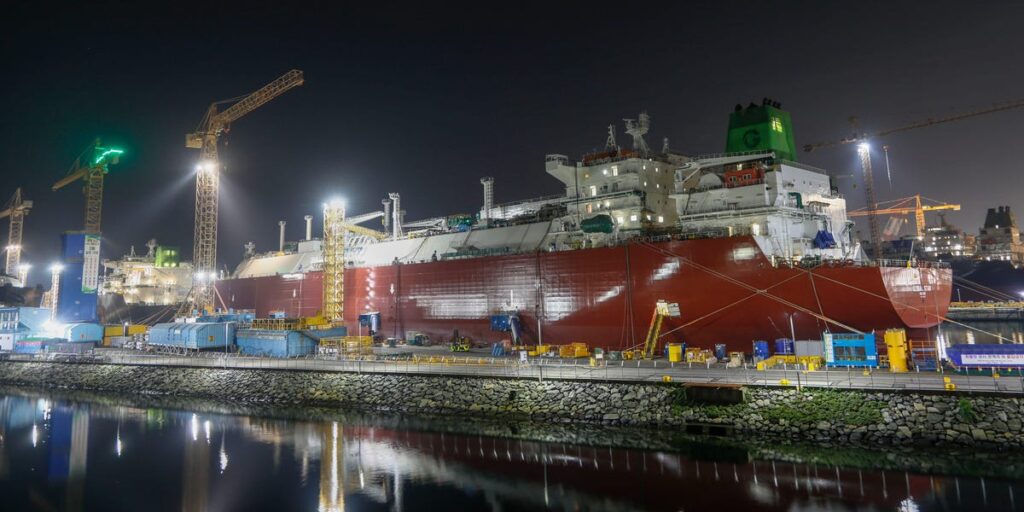US allies in the Pacific are ready to help fix American shipbuilding. But the problem is that Washington hasn’t been clear on what support it needs or how to coordinate it, US lawmakers say.
Shrinking yards, delayed programs, and spiraling costs have left the US shipbuilding industry struggling to maintain and sustain the Navy’s fleet, as well as support commercial endeavors. Meanwhile, rival China’s state-backed yards are turning out warships and commercial vessels at an alarming pace.
After a recent trip to South Korea and Japan, Sens. Tammy Duckworth (D-IL) and Andy Kim (D-NJ) told Business Insider that America’s partners are ready to pitch in but say the US hasn’t given them clear direction on how they can help with American shipbuilding and maintenance challenges.
A lack of direction
“There’s just genuine excitement and energy on the Korean side to move as fast as possible,” Kim said, but they’re “just waiting for the United States to tell them how high to jump.”
In South Korea, the senators met President Lee Jae Myung and executives from Hanwha Ocean, HD Hyundai Heavy Industries, and Samsung Heavy Industries — South Korea’s “big three” shipbuilding power players. And in Japan, they met with Mitsubishi Heavy Industries and the Keidanren Japanese Business Federation and Japanese External Trade Organization.
Talks focused on auxiliary vessels, fleet readiness, and sealift capacity, areas where both South Korea and Japan have competitive yards. Other economic investments, like energy and technology, were also discussed alongside broader national security ties.
Both Seoul and Tokyo have strong shipbuilding industries, the second and third largest in the Indo-Pacific, respectively, with shipyards capable of assisting the US in key areas.
The message from officials and industry leaders, though, is that there’s confusion in the cooperation.
“I think the one main ask of everybody we talked to, whether it was the shipbuilders themselves or government officials, was, ‘We don’t know who to talk to,'” Duckworth said.
Conversations bounce between US military offices, commercial firms, and government agencies with no single point of contact. Kim said there has been work with the Trump administration to find a point person, “some type of shipbuilding czar.”
The Trump administration already set up a White House office dedicated to fixing US shipbuilding, but it remains to be seen if that effort can cure the chronic cost overruns and program delays affecting the shipbuilding industry.
The Navy’s 2026 budget earmarks $47.4 billion for 19 battle-force ships, though much of the funding is conditional. At the same time, Washington is investing in modernizing shipyards and reviving a commercial sector that’s shrunk to a shadow of its former capacity, part of a broader effort to rebuild an industrial base now overshadowed by China.
And prior to her trip, Duckworth secured a provision in the 2026 National Defense Authorization Act requiring the Navy and Army to explore joint ventures with foreign partners on small vessels.
Pushing for more cooperation
South Korea has floated even bigger proposals amid other negotiations. In July, its finance minister announced a $150 billion package — branded “Make America Shipbuilding Great Again” — that would include building new US yards, training American workers, and servicing ships.
Duckworth and Kim said they presented strong bipartisan congressional support for shipbuilding cooperation to South Korean and Japanese officials and business leaders. But there are hang-ups to cooperation, such as visas, workforce challenges, communication issues, and misaligned shipyard capacity.
The senators’ trip to the Pacific came as leaders in Washington look closely at how to fix the decades-old shipbuilding problems that have left the US commercial sector diminished and contributed to the Navy’s problems building and maintaining its fleet.
When it comes to fixing shipbuilding problems, the urgency is growing. China is consolidating its massive state-owned shipbuilders into the China State Shipbuilding Corporation, cementing its position as an industry juggernaut while leveraging its industrial capacity to rapidly expand its navy.
Duckworth said that if the US is going to compete with China in shipbuilding, “then we really need to identify what our need is and what the plan is moving forward.”
Next steps, the senators said, are to appoint a lead US official, improve coordination, and give allies clear answers and tasks. Only then, the senators argue, can Washington turn enthusiasm in Seoul and Tokyo into steel in the water.
Read the full article here


